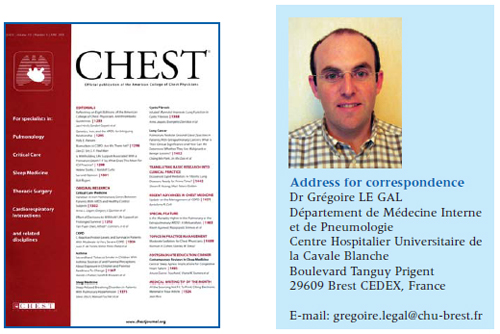About new articles
Kearon C, Kahn S R, Agnelli G, Goldhaber S, Raskob G E, and Comerota A J.
Antithrombotic Therapy for Venous Thromboembolic Disease: American College of Chest Physicians Evidence-Based Clinical Practice Guidelines
(8th Edition). Chest 2008;133:454S-545S
A Review by Grégoire LE GAL
The 8th edition of a “bedtime reading“ work for physicians involved in the management of Venous Thromboembolic Disease (VTED) (“Antithrombotic and Thrombolytic Therapy, American College of Chest Physicians Evidence- Based Practice Guidelines”, 8th edition) has just been published. This new volume, which is almost 1000 pages long, presents a state of the art description of antithrombotic agents (platelet anti-aggregants, anticoagulants, thrombolytics), their indications (VTED, atrial fibrillation, valvular heart disease, coronary artery disease, peripheral arterial disease or cerebrovascular disease), and also their complications (hemorrhagic events, heparin-induced thrombocytopenia (HIT) and the management of these disorders in a certain number of specific cases (perioperative period, children, pregnant women).
Before reading and using these recommendations, the reader needs to understand the important changes made in the methodology and how they were developed. The strength of the recommendation (1 : “We recommend”, or 2 : “We suggest”) no longer is based, as only a few years ago, solely on the type and quality of available studies. It is a true judgement on the overall value of the balance between the benefits and risks incurred by following this recommendation, a judgement based on the expected benefits in terms of health, treatment-related risks, patients’ values and preferences, but also on economic considerations and the allocation of resources.
What’s new in the treatment of VTED ?
Regarding acute deep vein thrombosis (DVT) and pulmonary embolism (PE), the novel aspect is the introduction of fondaparinux (a fixed-dose pentasaccharide administered as one subcutaneous injection a day), recommended in the same capacity as unfractionated heparin (UFH) or low molecular weight heparin (LMWH) (grade 1A). This treatment should be continued for at least five days and up until therapy with a vitamin K antagonist (VKA) started on day 1 of management becomes effective (INR>2 of at least 24 hours’ duration) (grade 1C). For DVT, ambulatory treatment is possible (1C).
The indications for aggressive management of DVT have been expanded. While in the previous edition, catheter-guided systemic thrombolysis or surgical thrombectomy were reserved for extreme cases (limb salvage, venous gangrene), they are now suggested interventions, with priority given to catheter-guided thrombolysis, for the prophylaxis of post-thrombotic disease in selected patients with acute symptomatic extensive proximal DVT, a low risk of bleeding, good functional status, and a life expectancy of more than one year. But caution is necessary. This is a grade 2B or 2C recommendation, and it is specifically mentioned that these procedures should be performed only if the appropriate expertise and resources are available.
One of the most striking changes is the duration of treatment. The recommended duration of treatment continues to be three months for thromboembolic events provoked by a major reversible risk factor (surgery, immobilisation, etc.). On the contrary, in patients who have had an event not provoked by such a factor, whereas the previous edition recommended initial therapy for 6 to 12 months followed by consideration of possible extended therapy, long-term therapy is now recommended (grade 1A) for all patients in the absence of a high risk of bleeding, and if good control of anticoagulation is feasible. Periodic reevaluation of the benefit to risk ratio is recommended. An exception is made for cases of isolated distal DVT where three months of anticoagulation is adequate treatment, even in cases of un-provoked events (grade 2B).
A major result of this stratification based on the provoked feature of the event or not and the recommendation of long-term therapy in the majority of patients with unprovoked VTED is that biological thrombophilias (factor V Leiden, etc.) have completely disappeared from these recommendations, while previously they were used to modulate the duration of treatment of patients with unprovoked VTED. This is probably justified, for example, regarding factor V Leiden, whose impact on the risk of recurrence is not clearly established. It is more debatable for antiphospholipids, which should always be screened for in patients in whom discontinuation of anticoagulant therapy is being considered.
Lastly, apart from antithrombotic therapy, the management of post-thrombotic disease (PTD) is discussed more thoroughly than in previous editions. The prophylaxis and treatment of PTD without an associated venous ulcer involves the wearing of compression stockings. If a venous ulcer exists, regarding physical measures to be taken, intermittent pneumatic compression therapy is suggested (Grade 2B). In terms of pharmacological therapy, the administration of local care and compression therapy is suggested in combination with pentoxifyllin, micronized purified flavonoid fraction or sulodexide (Grade 2B).

